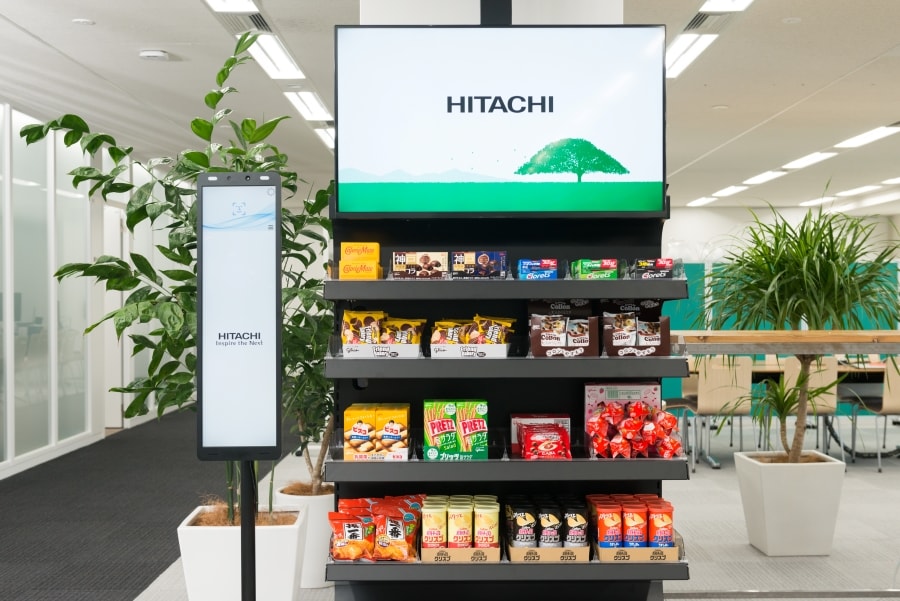What is Blockchain Technology Used in Cryptocurrencies and NFTs?: Intro to Features and Usage Examples
May. 10, 2022
Atsushi Fukuchi

Non-fungible tokens (NFTs) have been causing quite a stir in the digital art world as of late. NFTs are a technology that applies identifying information to digital artwork so that it can be proven that artworks are the sole property of their owners. The addition of "uniqueness" to digital artworks, which can be reproduced, has led to some artworks being sold for hundreds of millions of yen.
The technology that made this new structure possible is called "blockchain." Originally, it was popularized as a technology to support cryptocurrencies, but in recent years, its application has spread to other areas, attracting even more attention as a technology that can revolutionize our daily lives. This article provides an easy-to-understand explanation of blockchain technology, from its structure to cutting-edge usage examples.
What is blockchain technology?
It is difficult to define exactly what blockchain technology is, but it can essentially be summarized as a digital technology that shares data among multiple parties and records transactions accurately and permanently.
The name "blockchain" is derived from the fact that data is organized into units called "blocks," which are then connected and recorded like a chain. Whenever a transaction occurs, data such as who, when, and what kind of transaction is stored in a new block, which is connected to the end of the chain.
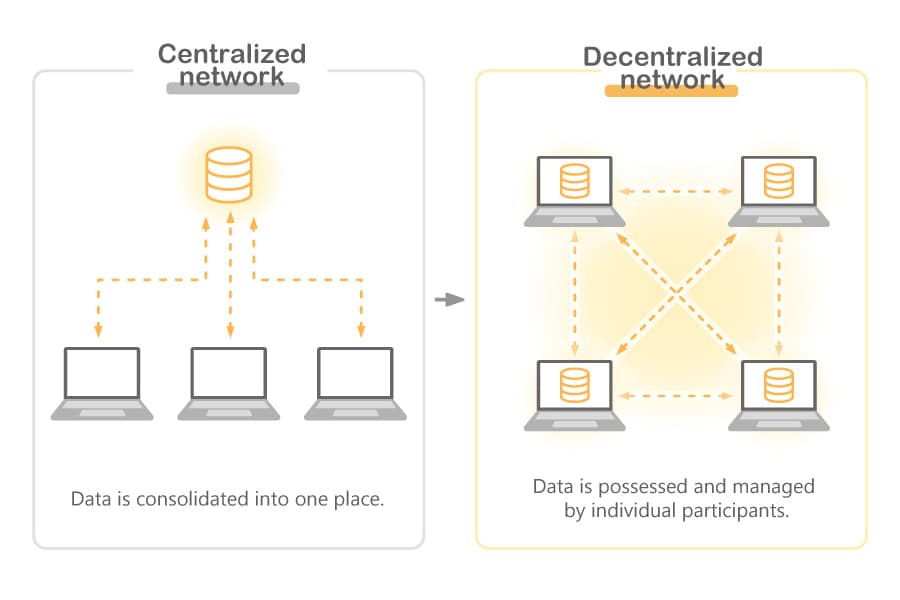
A blockchain can also be compared to a ledger because of its role in recording transaction history. Traditional databases also act as ledgers, but they are owned and managed by a specific administrator. This is called "centralized network."
In contrast, in a blockchain, the computers of many participants connected to the network each possess and manage the exact same ledger. Put simply, the exact same ledger exists for as many participants as there are participants. This makes it a “decentralized” technology.
Furthermore, because each ledger is synchronized on the network, when new information is added to one ledger, the information in the other ledgers is updated autonomously in real time. At first glance, having many ledgers that are exactly the same may seem wasteful, but this redundancy is actually one of the blockchain's great strengths.
This point will be discussed in more detail later, but first remember that a blockchain is referred to as a “distributed ledger” because of this structure.
What are the features of blockchain technology?
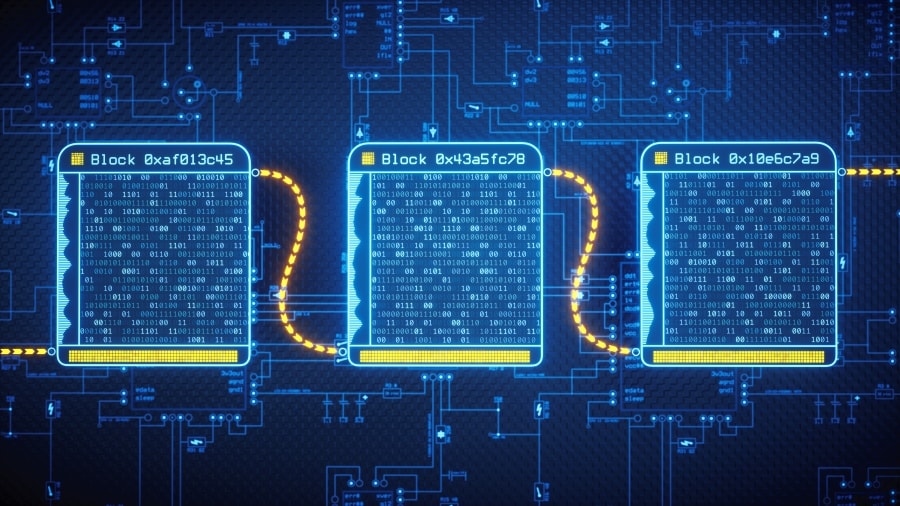
The first feature of blockchain technology, which is a means for administering to a distributed ledger, is that it is highly tamper-resistant.
In addition to transaction data, each block on the blockchain contains data called a "hash value," which is a summary (conversion) of the data from the previous block. The key point here is that the hash value can be completely different if the original data changes even slightly. Therefore, if a change is made to the data in one block, the hash value in the next block will not be consistent with the hash value in the previous block, and tampering will be detected.
To allow for successful tampering, the hash value of the next block, and the next, and so on would have to be changed endlessly as they are linked together.
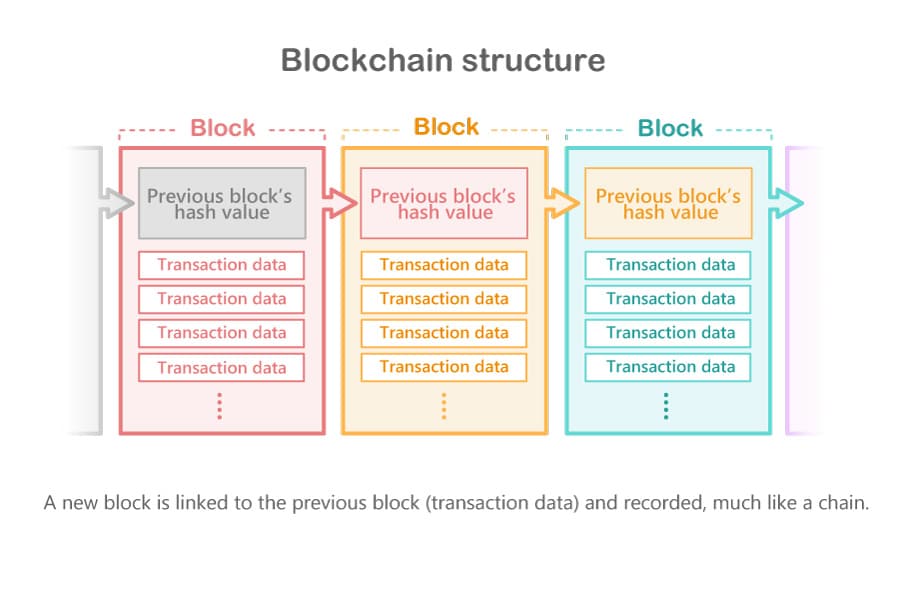
The fact that a blockchain is a distributed ledger makes tampering even more difficult. Generally, information is shared autonomously between each ledger only when a new block is added and when tampering or other unauthorized operations are not reflected in the other ledgers.
Therefore, even if all hash values are tampered with over time, new blocks are created in the meantime one after the other in other ledgers in the form of blocks with data before the tampering. This makes the ledger inconsistent with the ledgers possessed by other participants.
For the same reason, transaction data written to the blockchain cannot be deleted. This is because even if you delete certain transaction data from your ledger, the data will remain in other ledgers.
Furthermore, because it is distributed, it has a feature in which loss of ledger and transaction information due to the system going down is unlikely to occur. Even if some of the computers that make up the system go down, as long as the other computers are operating normally, the transaction data can continue to be recorded correctly. This is a significant advantage over centralized databases.
In sum, it can be said that blockchain technology is characterized by the fact that it is difficult to tamper with or delete data, and data loss is also unlikely to occur.
It is because of these features that blockchain technology first attracted attention as a means to support cryptocurrencies. Using blockchain technology enables participants to ensure the reliability and transparency of transactions between themselves without the need for an authoritative third party such as a state. Moreover, the blockchain is resilient to systems going down, reducing the risk that transactions stop.
Additionally, NFTs, which are digital data with an unforgeable certificate of authenticity and ownership issued on the blockchain, have been increasingly in the news these days, and their uniqueness can be guaranteed because the data on the blockchain cannot be tampered with or deleted.
Blockchain usage and examples
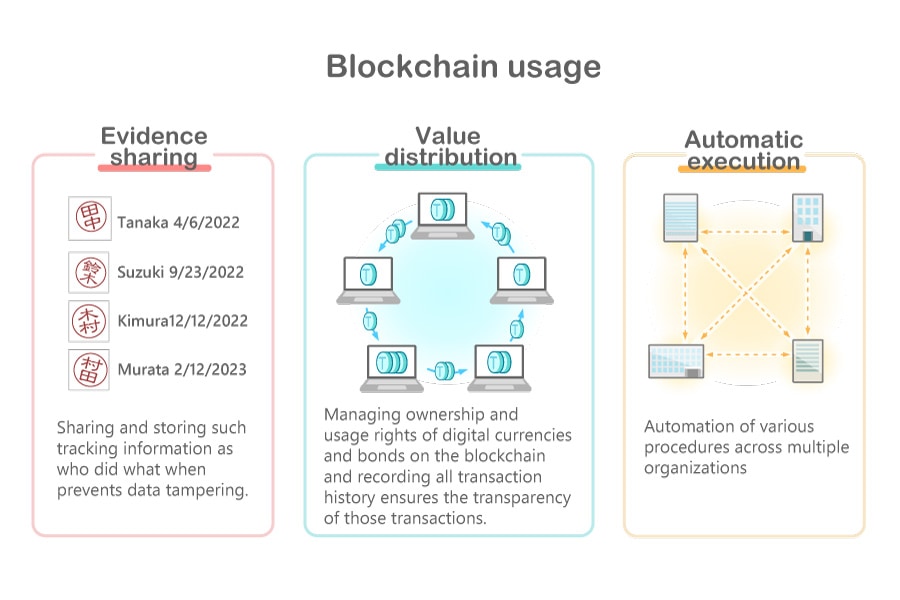
In addition to cryptocurrencies and NFTs, blockchain technology can also be applied to various economic activities. Its usage can be divided into three main categories.
Firstly, “evidence sharing” is used to deter data tampering by possessing and storing tracking information such as who did what and when. An electronic stamp is an example of this.
Next is “value distribution”, which manages the ownership and usage rights of digital currency and bonds on the blockchain and which records all transaction history to ensure the transparency of such transactions. This is a use case applied to cryptocurrencies and other applications.
Lastly, "automatic execution” automates various procedures between multiple organizations. This is an attempt to create new value by enabling multiple organizations to share data, and it is expected to lead to the emergence of services that were not available in the past.
Many businesses and services that use blockchain technology are being developed by combining these three use methods. The following are examples from Hitachi to show how they are being used in detail.
Example 1: Electronic signature services
The first obvious example is "electronic signature services" that digitize signatures required for contracts and other documents. Using the blockchain enables those who signed and stamped what and when to be electronically stored and recorded in a form that cannot be tampered with and that can be verified. Unlike paper-based signatures, these signatures can be searched for via a computer, and this can be expected to improve operational efficiency. At Hitachi, the system has been introduced in the procurement division to promote a paperless work environment.
Example 2: Supply chain finance platform
The use of blockchain technology in the finance industry is also advancing. Hitachi is currently working with Mizuho Financial Group, Inc., and Mizuho Bank, Ltd. on proof-of-concept (PoC) testing to realize a new payment platform for the supply chain in the logistics industry.
The logistics industry has a multiple-structured business flow in which logistics companies receive delivery requests from shippers and then outsource the transportation business to multiple carriers. Quotation and order management, vehicle dispatch and operation management, and billing management are conducted on an analog basis using telephones and e-mail. There is growing momentum within the industry to digitize these complicated procedures.
In an attempt to solve these problems, this PoC is testing the use of blockchain technology to realize a platform that unifies payment transactions across multiple businesses. The platform is expected to help small and medium-sized businesses struggling with cashflow problems by enabling the integrated management of money flow, commercial distribution, and logistics and by quickly converting transportation and delivery payments into capital.
Example 3: MaaS for tourism
Blockchain technology is also being used in tourism. Hitachi, in collaboration with map data provider ZENRIN Co., Ltd., is conducting PoC testing aimed at promoting tourism in Nagasaki City, Japan. The aim is to create Mobility as a Service (MaaS) that enables users to purchase and pay for various public transport and sightseeing tickets using a smartphone application, as well as to build a system for railroad and rental car companies, tourist facilities, retail stores, travel agencies, and others to share data via a blockchain.
High expectations for the proliferation in the future

In order to further use blockchain technology moving forward, it will be important to build a consortium. The blockchain will demonstrate its true value when it is used across multiple organizations. Conversely, if data is only managed and shared within an organization, a conventional centralized database can handle most tasks.
As these examples show, the value of blockchain technology should become clearer when multiple organizations and companies think of it as an essential tool for sharing data and know-how.
In the future, blockchain technology is expected to become an essential technology for social infrastructure. If the use of blockchain technology proliferates, it could become possible to close contracts for real estate, gas, electricity, water, and other services, as well as administrative procedures such as tax payments, with one smartphone, making it a one-stop shop.
Expectations are increasing that many organizations and companies will work together to unlock the potential of blockchain technology so as to further accelerate the digitization of society as a whole.
(Editorial supervisors: Hironori Emaru and Taichi Umeda, Hitachi, Ltd.)

